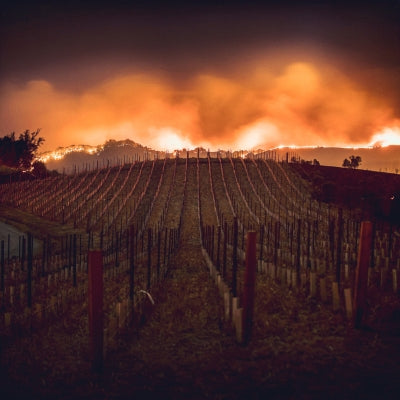
Vineyard threats: wildfires & smoke taint
In the third part of our series on vineyard threats and the impact of extreme weather, Westgarth Wines wine specialist Maurizio Broggi looks at the problems caused by wildfires & smoke taint.
Wildfires
The 21st century has witnessed a significant escalation in wildfire incidence across numerous regions experiencing hotter and drier climatic conditions attributed to climate change. This trend is particularly evident in fire-prone areas like California, Australia, South Africa, Canada, and Chile. In Australia, for instance, projections based on climate change models suggest a potential increase in bushfires ranging from 15 to 70% by the year 2050. The 2023 wildfires that swept across central and southern Chile caused extensive devastation, incinerating thousands of hectares of forests and agricultural land, with several hundred hectares of vineyards succumbing to the flames.
Even though the destruction of vineyards is a risk in areas prone to wildfires, the main concern is smoke taint in grapes, and consequently the wines.
The conditions for smoke taint
During the growing season, vines are sensitive to smoke, particularly when exposure to smoke occurs between veraison and harvest. This susceptibility is directly linked to the physiological state of the grapes. Softer berry skins, characteristic of later ripening stages, facilitate the absorption of smoke compounds compared to the firmer skins found in earlier developmental phases.
Furthermore, the extent of smoke taint is influenced by the duration and intensity of exposure. Vines primarily absorb smoke components through the berry cuticles, the waxy outer layer of the fruit, and to a lesser extent, through the leaves.
Grape varieties exhibit varying degrees of susceptibility to smoke taint. For instance, Sémillon grapes appear to be particularly sensitive in comparison to Chardonnay. This difference may be attributed to factors such as berry skin thickness and composition.
The impact of smoke taint
Grapes exposed to smoke during the ripening phase can impart undesirable sensory characteristics to the resulting wines. These include aromas and flavors described as ashy, burnt, intensely smoky, and reminiscent of bacon or smoked meats, often accompanied by a bitter aftertaste.
The underlying cause of these sensory defects lies in the absorption of volatile phenolic compounds derived from smoke by the grapes. While initially bound within the grape tissues, these compounds are released throughout the winemaking process, including during fermentation, aging, and even after bottling.
Preventative measures
Unfortunately, limited options exist for growers to prevent smoke taint once exposure occurs. While complete elimination of smoke taint may not always be achievable, some practices can potentially minimize its impact, however. These strategies primarily focus on minimizing the extraction of smoke-taint compounds during winemaking.
Handling
Careful handling of smoke-affected grapes is crucial, with practices like avoiding skin damage, minimizing skin contact time during fermentation (maceration), and utilizing lower processing temperatures all potentially contributing to reducing the extraction of smoke taint compounds.
Yeasts
The selection of yeast strains may offer another option for mitigating smoke taint. Certain yeast strains have been shown to possess the ability to transform or reduce smoke-character precursors, while others may exacerbate the sensory perception of smoke taint.
Blending
Blending smoke-affected wines with unaffected wines can be a worthwhile strategy to dilute the concentration of smoke taint compounds below the sensory threshold for consumers. However, the effectiveness of this approach is limited by the low detection threshold of smoke taint compounds.
Removal
Technological interventions such as reverse osmosis or the use of adsorptive resins have been explored for the removal of smoke taint compounds from wine. While offering some promise, these methods can also remove desirable flavor components and only target the free fraction of the smoke taint compounds, leaving the persistent bound fraction in the wine.
Want to read more? Take a look at some of our other blogs:



